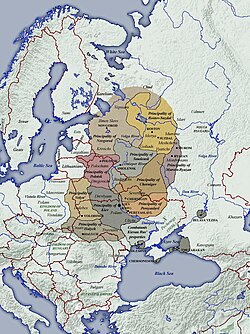Principality of Chernigov
| Principality of Chernigov | ||||||||||
| Чєрниговскоє кънѧжьство (Old East Slavic) | ||||||||||
| Principality | ||||||||||
|
||||||||||
|
Principalities of Kievan Rus' (1054–1132)
|
||||||||||
| Capital | Chernihiv | |||||||||
| Languages | Official language: Old East Slavic |
|||||||||
| Religion | Official religion: Orthodox |
|||||||||
| Government | Monarchy | |||||||||
| Legislature | Prince | |||||||||
| History | ||||||||||
| • | Established | 988 | ||||||||
| • | Disestablished | 1402 | ||||||||
| Currency | Grivna | |||||||||
|
||||||||||
| Today part of | Russia, Ukraine, Belarus | |||||||||
The Principality of Chernigov (Old East Slavic: Чєрниговскоє кънѧжьство, Ukrainian: Чернігівське князівство) was one of the largest states within Kievan Rus'. For a time the principality was the second most important after Kiev.
Most of the Principality of Chernigov was located on the left bank of the river Dnieper, within the basins of the Desna and Seim rivers. The principality was supposedly populated by mostly Slavic tribes of Siverians and partially by the Dnieper Polans. Later the territory of the principality extended to the lands of Radimichs and partially the Vyatichs and Drehovichs. The capital of the principality was the city of Chernihiv (Chernigov). Other important cities were Novhorod-Siversky, Starodub, Bryansk, Putyvl, Kursk, Lubech, Hlukhiv, Chechersk, Homel (Gomel), Bilhorod (Belgorod), Vyr, and others. Ownership and influence of the Chernigov Principality reached far to the North (to the Murom-Ryazan Land) and to the South-East (Tmutorokan Principality).
...
Wikipedia


